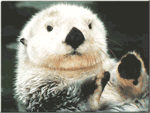 The sea otter (Enhydra lutris) is the heaviest of its kind, weighing up to 45 kg. It has been hunted extensively in the eighteenth and nineteenth century for its warm fur. As a positive side effect, due to the hunting, to maximize profits the sea otter's behavior was researched extensively. The sea otter (Enhydra lutris) is the largest member of the family Mustelidae. It is also the only marine mammal in the order of Carnivora and is the smallest marine mammal. If sea otters rest they are among kelp or in quiet water, laying on their backs. The common resting position is with the head up, with folded paws and chin resting on their chest.
The sea otter (Enhydra lutris) is the heaviest of its kind, weighing up to 45 kg. It has been hunted extensively in the eighteenth and nineteenth century for its warm fur. As a positive side effect, due to the hunting, to maximize profits the sea otter's behavior was researched extensively. The sea otter (Enhydra lutris) is the largest member of the family Mustelidae. It is also the only marine mammal in the order of Carnivora and is the smallest marine mammal. If sea otters rest they are among kelp or in quiet water, laying on their backs. The common resting position is with the head up, with folded paws and chin resting on their chest.
Which zoos have them?
Minnesota Zoo (United States)The Sea otter is listed as Endangered (EN), considered to be facing a very high risk of extinction in the wild, on the IUCN Red List of Threatened Species
Namings for the sea otter
A young / baby of a sea otter is called a 'pup or whelp'. A sea otter group is called a 'romp, bevy, lodge, family or raft'.Sea otter habitats
Coastal Brackish / Saline Lagoons / Marine Lakes, Estuaries, Macroalgal / Kelp, Marine Coastal / Supratidal, Marine Intertidal, Marine Neritic, Mud Flats and Salt Flats, Rocky Shoreline and Salt Marshes (Emergent Grasses)Some facts about the
Sea otter
Adult weight : 25.85 kg (56.87 lbs)
Maximum longevity : 27 years
Female maturity :974 days
Male maturity : 1369 days
Gestation : 140 days
Weaning : 175 days
Litter size : 1
Litters per year : 1
Interval between litters : 548 days
Weight at birth : 1.868 kg (4.1096 lbs)
Weight at weaning : 13.425 kg (29.535 lbs)
Basal metabolic rate : 98 W
Body mass : 26.833 kg (59.0326 lbs)

Custom Search